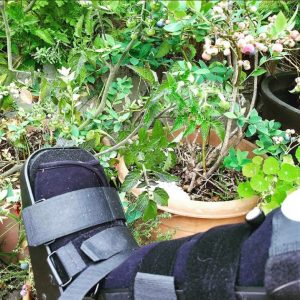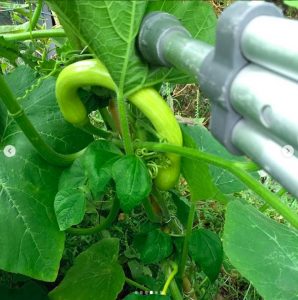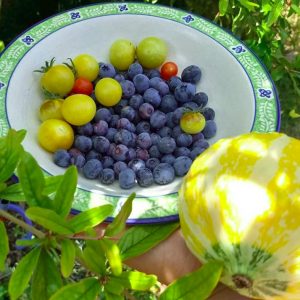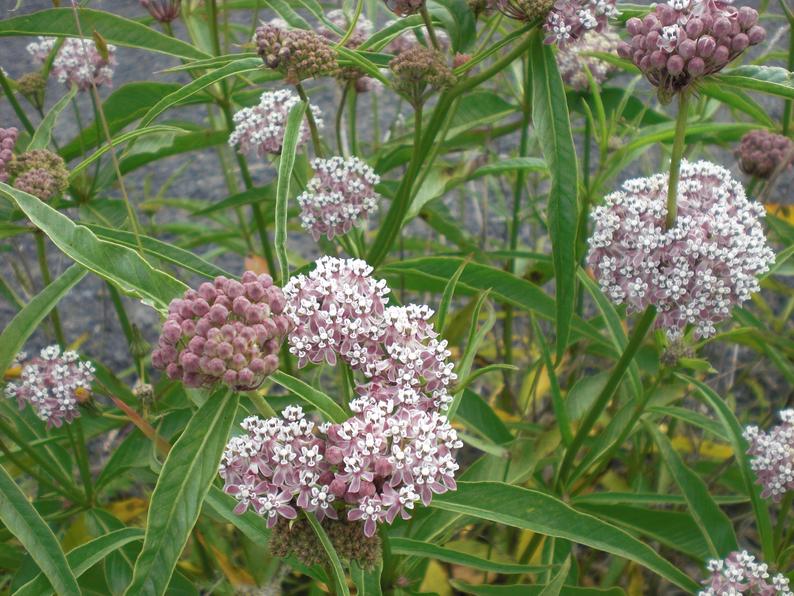Gardening on Crutches

If you follow me on Instagram, you may have already heard that Summer 2019 is the year of gardening on crutches.
In early June, I fell and fractured 3 bones in my ankle (if you’re gonna do it, do it right!), and I’ll be on crutches well into August.
Which posed some interesting questions: How would I water and harvest my garden? And what am I learning through this experience?
1. Plant early. You never know what might happen.
Luckily I had planted most of my summer vegetables early in the season, thus before I fell. I had built up my soil and planted out the babies I’d been nursing along in my greenhouse. As luck would have it, I had planted blueberries and tomatoes (Napa Chardonnay – yum!) in large containers all around my patio, which have been easy to access and have given me some fun harvest moments.
2. Accept what is.
There were a few plant babies left at the time of my fall, but I accepted that they won’t be headed into the garden. I’ve had to accept that the front yard will look weedy, probably all summer long — and that means it will redeposit seeds so I’ll have extra-more weeds next year. I’ve accepted that many of my grand plans for this season simply won’t get done.
And I’ve also had to accept that the kabocha squash and watermelons, that I had planted before I fell, really are going to take over the side garden. I watch them climb through the branches of the pomegranate tree and rampage OVER the strawberry guava, and I wonder how this will all turn out in another two months …
3. Accept help.
In the first weeks, friends and family came over and watered my garden (thanks Ashley, Carter, Alexis, Hannah!). I needed help not just in the garden, but inside the house — simple logistics (like carrying a teacup) became a huge challenge. David has stepped up in awesomeness.
It is impossible for me to navigate inside my garden beds, even with all the enlarged stepping stones I had recently added. I have to rely on friends and family (thanks Linda, Elizabeth!) to harvest the plants in the interior which I can no longer reach.

4. Understand the Gift of mobility.
I’ve always been blessed by being physically able. This is my first journey into mobility challenges, and it has really opened my eyes. Sure, in the past I thought ADA and providing for people who had mobility challenges was a good idea. But I didn’t really understand.
Last month, the first time I stood at the bottom of a staircase and realized there was no other way into a building without a huge and painful climbing effort made me truly appreciate all the ramps California has mandated. I’ve been thankful that those who have been down this road before me insisted upon 36″ clear pathways free of trip hazards, substantial handrails on stairways, and a decent turning radius with heavy-duty handrails inside restrooms.
And I’ve learned that chip-bark mulch in gardens is one of the worst surfaces on crutches (sorry Dorothy!).
(I’ve also been puzzled by the braille dots that are appearing on all public curbs, I’ve read that they are for the visually-impaired. Yet at the same time they are no picnic to jostle across when you’re in a wheelchair in pain, they’re absolutely treacherous when you’re on crutches, I cannot imagine how they work with a walker’s tiny wheels, and they’re quite slippery to women in leather-soled shoes or high heels. In spite of my challenges with curbs, I find myself scanning for places to climb the curb without the dots. Why was this design selected?)
5. Pride in what you Can do
Now that I’m beyond the pain, and into the waiting-for-the-bones-to-grow-back phase, I’ve had to become really ingenious. I’ve invented ways to maneuver a pitcher of water across a room to water my houseplants. I’ve become calculating about getting multiple things done in a single crutches-pass around the room. I’ve learned how to drag garden hoses despite the crutches. My husband put out milk crates around the garden so that I can sit down to work with the plants around the edges. Rather than focusing on the limitations, it’s become about increasing the list of things I CAN do.

6. The desire for Normal.
If you have someone in your life who is suddenly less-able, realize that it’s the little things that make up Normal. And a stir-crazy patient craves anything that might make her feel a bit Normal — whether that’s a conversation about something other than the injury/illness (thanks Ashley and Azita!), or pursuit of a hobby from the old days that she can still participate in (thanks Linda for pursuing the Welcome Blanket project right now!). Even being taken out to a Normal restaurant becomes a Very Big Deal (thanks Julian and Alexis!).
Right now, just crutching around my patio, harvesting my Napa Chardonnay tomatoes, is a tiny bit of Normal that keeps me going. I’ve learned to pack an over-the-shoulder go-bag before I venture down the stairs. The bag carries containers to collect seeds, as well as plastic tubbies to collect harvested tomatoes. It’s a very different sort of gardening, but it feels good to be able to achieve even this limited amount.
Update: Tips for Gardening on Crutches
Someone recently asked for an update, any more tips I might have to share. In reflection (it’s now been 2 yrs, the ankle is healed, and through hard work in physical therapy + yoga I have regained about 85% of my prior mobility) …
7. Focus on what you can access
The parts of my garden I was able to work/play in while on crutches were (1) the potted plants around my patio (container blueberries, tomatoes, basil, strawberries) and (2) the strip of garden that immediately edged the wide pathways. I found I could sit on an upended crate and work about 3/4 of an arm’s length into the garden. Anything that didn’t fit into those two categories didn’t get touched by me for many long months.
So, container gardening: Perhaps you can get a helpful gardening friend to come over and set up some pots with potting soil, then you can plant them. What to plant, and how to care for it? Check out my Food from a Flowerpot book.
the narrow strip of garden along the pathways: In my garden, the Year of the Ankle, it was simply those plants which were already in-ground, planted before I fell. I had bush squashes, basil, and flowers as I recall. You could plant pretty much anything, but if you are planting new things, I’d recommend you focus on plants which have a compact growth habit. That means they’ll stay small and you’ll be able to reach most of the plant.
8. Love your fallow
For those parts of your garden which are inaccessible to you on crutches, you have two options: (1) get helpers (I wrote about helpers at #2 above), or (2) let those areas go fallow, which means let them go wild. I did a combo of the two.
In contemporary gardening, we (society) undervalue the idea of fallow. In vegetable gardens, we tend to have this obsession with maximum yield, or keeping everything in production. In ornamental gardens, we tend to dislike “messy.” But a time of fallow is really good for your soil health.
If you can, plant a “soil building” crop, like legumes or a combination of legumes, mustards, and other plants like buckwheat, vetch, clover. This soil-building crop recirculates nutrients within the soil, and keeps your soil organisms alive and happy. Your soil organisms, together with mycorrhizae, will appreciate the vacation from tilling and disturbance. In dry climates like Southern California, you do have to water the fallowed section.
If you live in a place that gets rain, or you live in SoCal and ended up on crutches in the autumn, you might try planting feral vegetables. Get my Vegetables Gone Wild info sheet.
9. Garden tasks while on crutches
For harvesting, I made a little “go kit” with everything I anticipated needing each time I crawled down the stairs. I describe part of the “go kit” in #6 above. As I healed, and was in less immediate discomfort, the “go kit” expanded to include a few small garden tools, clippers, etc. so that I could poke at those plants I was able to access, to do deadheading, etc..
For watering, during the time when I couldn’t put my foot down at all, I developed a technique for hauling garden hoses. While holding onto something solid for balance, I’d one-hand tug the hose as far as I could. If that wasn’t enough, I found I could balance on my good foot with one crutch wedged under my armpit, then use the other crutch to tug the garden hose a few additional feet in the needed direction. Thumb valves at the hose end, plus fan sprayers, helped me water a good portion of the garden (not 100%). During this time period, I must admit I succumbed to doing overhead watering (I know, I know, far less water-efficient) simply because I couldn’t manage anything else.
I didn’t mention it in the original post, but for a short time I used a knee scooter. For me this was SUCH a relief from crutches! That said, knee scooter + chipped bark mulch + garden hoses is a recipe for disaster. I found I was top-heavy, and the mulch tugged at the little wheels, which made a hazard for a possible second fall. Crutches were much wiser than scooters for gardening.
For chair time: I put a big basket next to the chair I lived in for those first few months. The basket included all my fave garden catalogs, plus pens and paper. It was a great time to rethink my garden, to dream, and to plan. Let your fantasies go wild! Rather than focusing on what you can’t do right now, focus on the planning and dreaming aspect of your garden — and I’ll bet it will bring you a bit of the peace and satisfaction that your garden brought you in the before-times.
Bird-watching: My chair was set up facing out a big window into my garden. I’ve never been a bird-watcher, but bird-watching has long been on my “I’ll do someday” list. From my chair, I took online bird-watching classes (Audubon Society and Cornell Lab offer them). I put bird-watching apps like Merlin and eBird on my phone. I put binoculars and a Sibley’s guide in my chair-side basket. Oh what I learned! I never knew I had Orioles visiting my garden! I learned I had not one, but several species of hummingbird. It felt great to explore a new hobby while chair-bound, and to learn a new dimension of my garden.
10. The long road back
For me, healing was far from instantaneous. I learned pretty quickly that the M.D.’s give you optimistic estimates to keep you motivated. Such as “you’ll be off crutches in 6 weeks” which really translated to “you’ll begin excruciating and exhausting physical therapy in 6 weeks, at which point you’ll have to learn how to walk all over again.” Don’t expect to pop back onto your feet right away.
And, once you do get back on your feet, your balance might not be what it was in the before times. Mine wasn’t. And in some instances, 2 yrs on, it’s still not back to before-times levels. So I’ve modified a lot of my surroundings. I’ve widened pathways. I’ve changed out the tiny (free) stepping stones I used to have for much bigger slabs which accommodate two feet. And those new stepping stones are spaced much closer together than when I was younger.
It’s all in the evolution of a garden. Permaculturre teaches us to design for the needs, rather than imposing a concept upon the space. That is to say your Season of Crutches will change you, and it will change your garden too.
I wish you a speedy recovery! And, while you’re going through your recovery, I hope you find some peace and fun and sunshine in your garden!


One Comment
Grace van Thillo
Sending healing blessings that each day your mobility and comfort increase; and the garden continues to thrive.